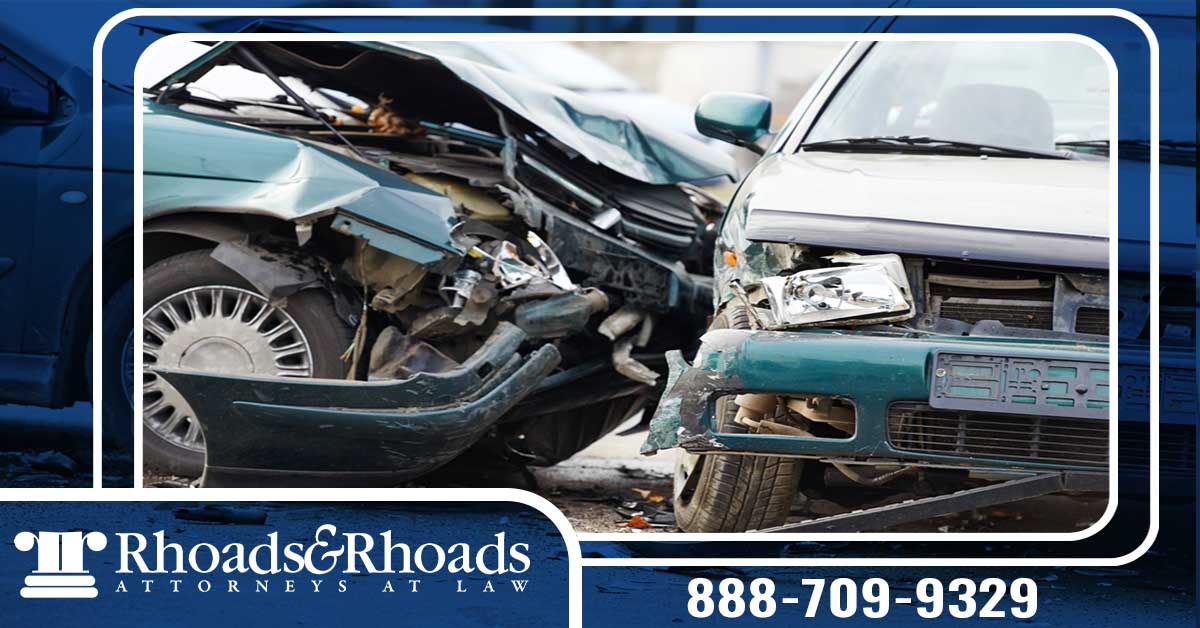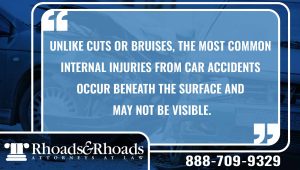
Every year, countless individuals suffer from internal injuries after a car accident, a silent and often overlooked consequence of motor vehicle collisions.
Internal injuries from car accidents can be life-threatening and require immediate medical attention.
Can I Sue After a Car Accident That Caused Internal Injuries?
If you have suffered internal injuries from a car accident caused by someone else’s negligence, you have the right to seek compensation through a lawsuit.
To pursue an injury claim or ultimately to file a lawsuit after an auto accident that causes internal injuries, you must establish that another party’s negligent behavior directly caused your injuries.
At Rhoads & Rhoads, we are committed to providing empathetic, professional, and ethical support to every car accident victim who sustains internal injuries.
Call 888-709-9329 to schedule a free consultation with one of our Madisonville or Owensboro car accident attorneys
Common Types of Compensation Available to Car Accident Victims
Medical costs: These include emergency care, hospitalization, surgery, medications, adaptive devices, ongoing medical treatment, and follow-up related to the car accident. They also include treating emotional distress.
Lost wages: Compensation for any income the injured person lost due to the inability to work while recovering from their car accident injuries.
Pain and suffering: Emotional distress damages and compensation for the physical pain caused by car wrecks.
Rehabilitation costs: Expenses for physical therapy and other rehabilitation services needed to recover from auto accidents.
Property damage: Compensation for any damage to your vehicle or personal property.
The Legal Process for Filing a Car Accident Claim
- Consultation: Start by consulting with a personal injury lawyer to discuss your case and understand your legal options.
- Investigation: Your car accident lawyer will gather evidence that proves your case, including medical records, accident reports, and witness statements.
- Filing a claim: Your auto accident lawyer will file a claim against the responsible party’s insurance company or directly against the party in court.
- Negotiation: Most cases related to internal injury motor vehicle accidents are settled without going to trial.
- Litigation: If the at-fault party won’t agree to a settlement, your lawyer will argue your case before a judge or jury.
Car accident internal injury cases can be complex, especially those involving TBIs and spinal cord injuries, and a skilled personal injury lawyer knows how to fight for you.
If you’ve sustained internal injuries, call 888-709-9329 today for a free case evaluation.
What Are Common Internal Injuries?
 Internal injuries occur when the body is hit with significant force, like the impact of a car accident.
Internal injuries occur when the body is hit with significant force, like the impact of a car accident.
Unlike external injuries, victims sustaining permanent injuries are often unaware of severe injuries potentially leading to lifelong pain or death.
Further complications are common when emergency responders are not available to warn injured victims of potential hidden injuries.
Internal injuries typically fall into these categories:
Internal bleeding: Internal bleeding happens when blood vessels are damaged and blood leaks into surrounding tissues or cavities. It can lead to severe blood loss and organ failure if not treated promptly.
Organ damage: Car accidents can cause damage to vital organs like the liver, spleen, and kidneys. Such injuries can disrupt organ function, leading to serious health problems.
Fractures: Fractures related to auto accidents can result in internal injuries. Broken bones (especially a broken rib) can puncture or compress internal organs, leading to severe complications such as punctured lungs or damage to other internal tissues.
Traumatic Brain Injuries (TBI): An auto accident-related Traumatic Brain Injury occurs when the brain strikes the inside of the skull during a car accident, leading to permanent injuries from concussions, contusions, or hematomas. Symptoms of Traumatic Brain Injuries range from headaches and dizziness to severe cognitive impairments.
Common internal injuries from car accidents may not be obvious right away but require immediate medical attention.
Symptoms of Internal Bleeding and Injuries from Car Accidents
Internal injuries from car accidents can be challenging to identify because they do not always show immediate symptoms.
Unlike cuts or bruises, the most common internal injuries from car accidents occur beneath the surface and may not be visible.
Symptoms include:
 Severe pain: Abdominal pain, chest pain, or headaches can indicate internal injuries and should be promptly evaluated.
Severe pain: Abdominal pain, chest pain, or headaches can indicate internal injuries and should be promptly evaluated.- Swelling and bruising: Unexplained swelling or bruising may suggest internal bleeding or organ damage, especially in areas not directly impacted.
- Dizziness and confusion: Dizziness, confusion, chest pain, or fainting can be signs of internal bleeding or low blood pressure due to internal injuries.
- Loss of consciousness: Losing consciousness can indicate significant internal injuries such as a concussion or brain bleed.
- Nausea and vomiting: Nausea, vomiting, or a general feeling of illness may indicate internal injuries, especially if related to the digestive system or blood loss.
How Are Internal Injuries Diagnosed?
Diagnosing the most common internal injuries requires victims to seek medical attention immediately to prevent serious complications.
Many injuries are not immediately apparent, and even with no obvious symptoms, any internal injury can be life-threatening.
A variety of methods are used to diagnose bleeding internally, spinal cord injuries, broken bones, abdominal aorta aneurysm, broken ribs, or other life-threatening complications of a severe auto accident, including:
Initial Medical Evaluation
Seeing a doctor immediately begins with a thorough physical examination to assess your symptoms and look for signs of internal injuries, such as pain, swelling, or bruising.
CT Scans
A CT scan (computed tomography) provides detailed images of organs, bones, and blood vessels. It helps detect internal bleeding, fractures, and organ damage by taking cross-sectional images that reveal areas of injury.
X-Rays
X-rays commonly identify fractures and bone injuries that may not be immediately apparent. They can also detect certain types of serious internal injuries caused by bleeding and tissue damage.
MRIs
An MRI (magnetic resonance imaging) uses magnets and radio waves to examine soft tissues, organs, and complex bone fractures that may not be visible on X-rays.
Ultrasounds
Ultrasounds use sound waves to create images of internal organs and tissues. They are often used to detect internal bleeding, fluid collections, and damage to organs such as the liver or spleen.
Blood Tests
Blood tests can reveal internal bleeding and organ damage by detecting abnormal levels of blood components, such as hemoglobin and hematocrit. Elevated white blood cells, disease-fighting blood cells that help the body fight infection, may indicate inflammation or infection.
What to Do if You Believe You Have Internal Injuries from a Car Wreck
- Check for injuries and call emergency services: Check yourself and others for blunt trauma, severe bruising, difficulty breathing, broken ribs, or other injuries. Then, call 911 and seek medical attention.
- Offer safety and secure the scene: If safe, move your vehicle out of traffic, turn on hazard lights, and stay inside with your seatbelt fastened if the car cannot be moved.
- Seek a medical evaluation: See a medical professional even if you feel fine, as some injuries may not immediately show symptoms.
- Report the auto accident: Contact the police to report the car accident and provide accurate details for an official record.
- Exchange information: Swap contact and insurance details with other drivers and collect information from witnesses.
- Document the scene: Take photos or videos of the scene, including vehicle damage, and note the time, date, and location.
- Notify your insurance company: Promptly report the auto accident to your insurer and provide relevant details and documentation.
- Avoid admitting fault: Do not admit fault or apologize; provide only factual information and let the investigation determine fault.
- Follow up with medical care: Continue with medical follow-up and keep records of all treatments and expenses.
- Contact a car accident lawyer: Consult a lawyer, especially if you have significant injuries or damages, for help with claims, settlements, or legal action.
- Preserve evidence: Keep all documents related to the auto accident, including medical records and repair estimates, to support your case.
Sustain Injuries in a Car Crash Accident? Call Our Accident Attorneys Today
Rhoads & Rhoads’ Kentucky car accident attorneys have years of experience handling cases involving life-changing internal injuries.
We get paid only if we win or settle your case, and NO RISK is involved.
Call us at 888-709-9329 to schedule a free consultation with one of our Madisonville or Owensboro car accident attorneys.


